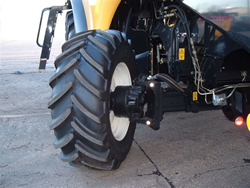
Arable farmers faced a multitude of problems due to the rain during the 2004 harvest. In addition to interrupted progress, the cumulative rainfall meant that, even when the crop did have a chance to dry out, the ground remained too waterlogged to allow combining without the risk of getting stuck, serious rutting or damage to the soil structure.
One group of cereal producers, however, was in a better position than others to get onto the land – those with four-wheel-drive combines. All-wheel-drive tractors have been around for many years, but the same feature on combines is not so common.
New Holland has offered four-wheel-drive as factory-fit option on its CX and CR Series combines since they were launched. Now the benefits of greater traction and distributed drive are available for customers wishing to upgrade their existing CX and CR combines with a brand-approved dealer-fit system.
One grower, who took advantage of adding four-wheel-drive this year, was Northumberland-based farmer and contractor Pip Robson. Mr Robson, who farms at Chathill and harvests up to 2,200 acres of oilseed rape, barley, wheat and beans each year, noticed an immediate benefit from the system when it was fitted to his CR980 halfway through its second season.
"To be honest I would have probably specified four-wheel-drive if I had had the chance," Mr Robson says, "but after my previous combine was destroyed by fire last year, I bought a CR980 that Lloyds' Kelso branch had been planning to run as a demonstrator.
"The dry 2003 harvest meant I didn't have any problems with the combine, but one week into the 2004 harvest I had made up my mind that four-wheel-drive was a must. Tracks weren't really an option because we do so much road work."
It took just one day to retro-fit four-wheel-drive to Mr Robson's combine. "We delivered it to the dealer one evening and it was ready to collect by tea time the next day – and was back to work the following morning," Mr Robson says.
The upgrade involves replacing the combine's existing free-turning rear axle hubs with two which are hydrostatically-driven. The CR and CX Series combines already feature hydrostatic drive to the front axle, so the oil supply is simply redistributed to drive the new back axle hubs as well.
Mr Robson describes some of the parcels of land that he harvests as deep and peaty. "The soil goes down for about 10 to 12 feet and isn't very stable," he says. "And it certainly doesn't carry machinery very well when it's wet.
"Four-wheel-drive kept the combine out of difficulty, but I also used it to spread the power and reduce the damage to the fields," he says. "The traction comes from all four wheels so the tyres didn't even break the surface. With so many benefits, the system is a cost-effective option.
"I was able to harvest three fields totalling about 100 acres that I wouldn't have been able to go near with a two-wheel-drive combine. And if it hadn't dried up a bit towards the end of the harvest, a further 50 acres would have been in the same situation."
Adding all-wheel-drive to his CR980 also improved its performance on hills. "There are a couple of slopes that I harvest that I have only been able to cut while going down hill in the past," Mr Robson says. "With four-wheel-drive engaged, I was also able to cut going up the hill this year, making the process much more efficient."
The benefits of New Holland's upgrade made a big impression on Mr Robson. "If people realised the difference it makes, everyone would use four-wheel-drive combines," he concluded.
